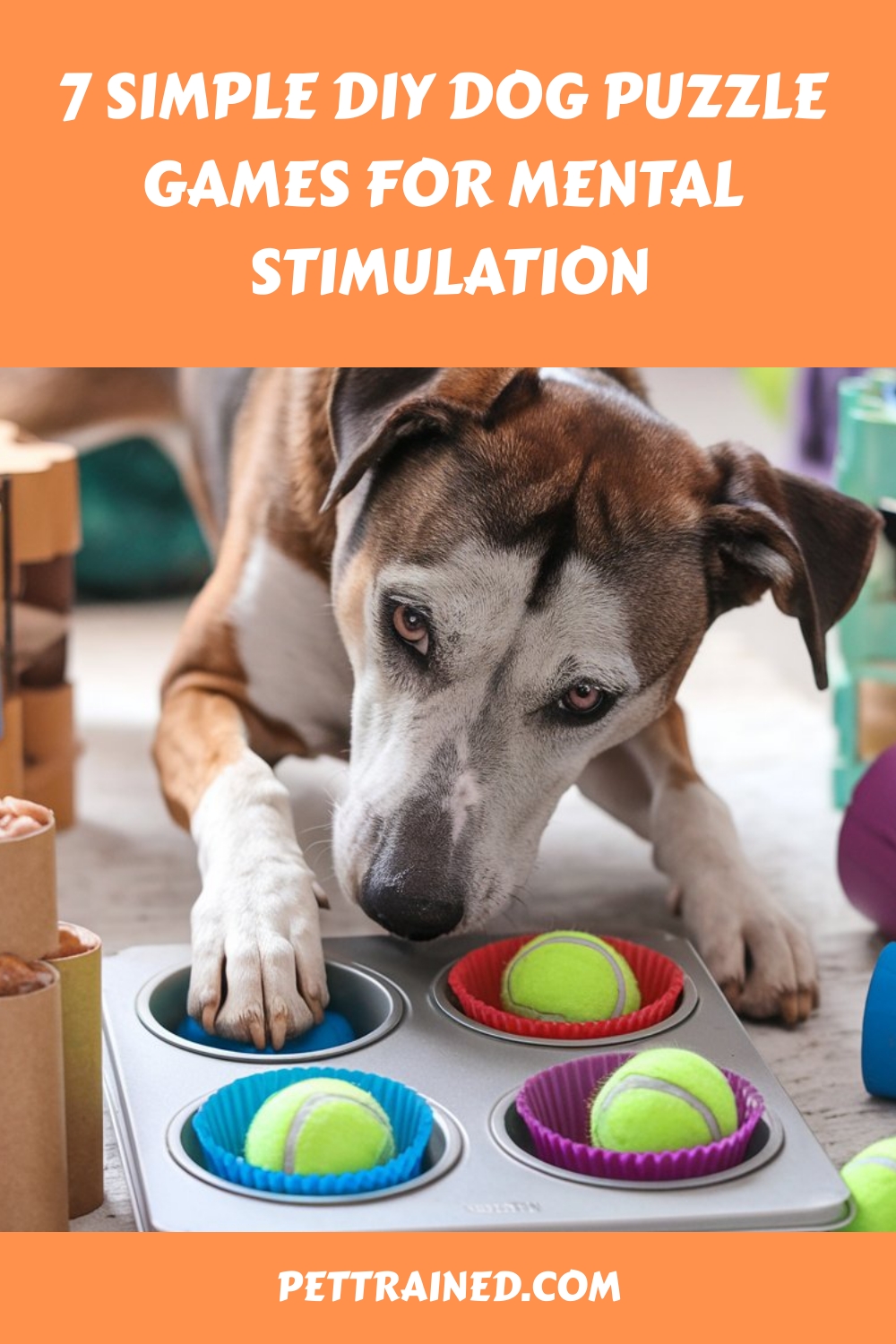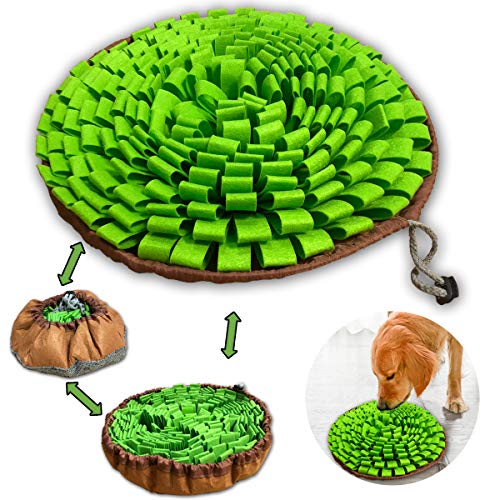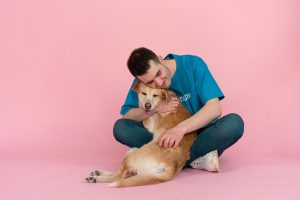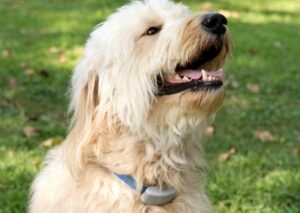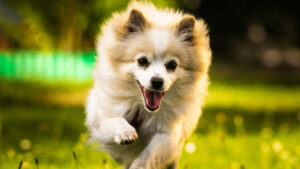Does providing mental stimulation for your dog really lead to a happier and healthier pet? You’ve likely heard the theory, but is it true for your furry friend? When you engage your dog’s mind with puzzle games, you can challenge their problem-solving skills and provide entertainment. But where do you start? You don’t need to break the bank on expensive toys – simple DIY games can be just as effective. From cardboard box mazes to repurposed treat dispensers, the possibilities are endless. Let’s explore seven easy and fun options to keep your dog’s mind active. Here are seven simple DIY dog puzzle games for mental stimulation.
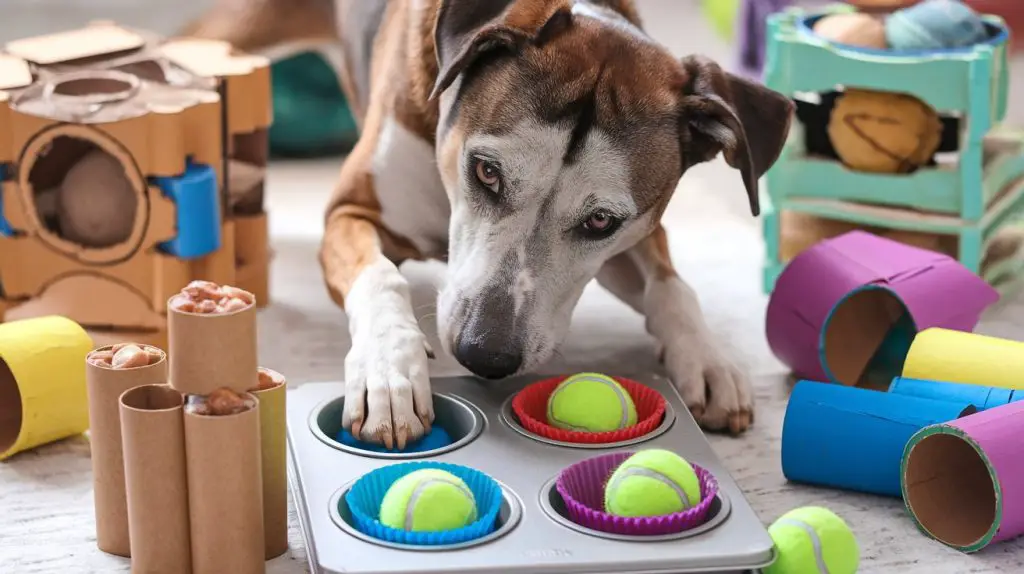
Table of Contents
1. Cardboard Box Maze Challenge
To create a Cardboard Box Maze Challenge for your dog, start by gathering a large, sturdy cardboard box, such as a refrigerator or appliance box, and a few of your dog’s favorite treats.
To create a cardboard maze for your dog to navigate, you’ll need to cut holes of varying sizes in the box. The maze’s complexity will depend on the size and number of holes you create. For a beginner-level maze, start with larger holes and gradually decrease their size as your dog becomes more confident in its maze navigation skills.
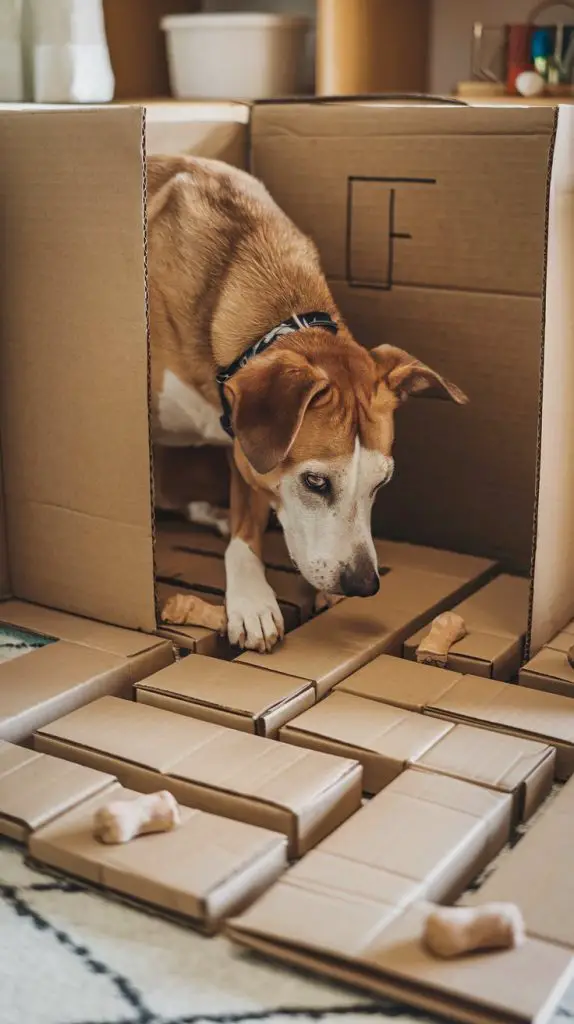
This DIY puzzle game offers an affordable alternative to interactive smart toys and provides similar mental stimulation benefits for your pet.
As you cut the holes, consider the path you want your dog to take through the maze. You can create a simple linear path or a more complex route with multiple turns and dead ends.
This post contains affiliate links. However all the information provided on this site are my own honest opinions. See more in Disclaimer.
Place the treats inside the box to entice your dog to navigate the maze and find them. You can also add a few treats outside the box to encourage your dog to enter the maze.
2. Interactive Treat Dispenser
Creating an Interactive Treat Dispenser is a simple and effective way to challenge your dog’s problem-solving skills. By creating a puzzle that requires your dog to work for treats, you’ll provide mental stimulation and slow down eating. This project leverages treat motivation to encourage puzzle engagement, keeping your dog focused and engaged.

Regular use of such puzzles can help maintain your pet’s mental well-being, much like how regular nail grooming promotes overall health.
To create an Interactive Treat Dispenser, you’ll need a few basic materials, including:
- A plastic container with a removable lid, such as a margarine tub
- A sharp utility knife or drill
- A piece of wood or plastic to create a movable puzzle piece
- Treats of varying sizes to challenge your dog
- A non-toxic adhesive, such as hot glue
Cut or drill holes in the container to create a challenging puzzle. Attach the movable puzzle piece to the container using the non-toxic adhesive. Fill the container with treats, and let your dog figure out how to get them out.
As your dog becomes more skilled, you can increase the difficulty of the puzzle by adding more complex puzzle pieces or using smaller treats.
3. Problem-Solving Plastic Bottle Game
Numerous household items can be repurposed to create engaging puzzle games for your dog, and one of the most versatile is an empty plastic bottle. You can transform it into a problem-solving game that challenges your dog’s cognitive abilities and provides mental stimulation.
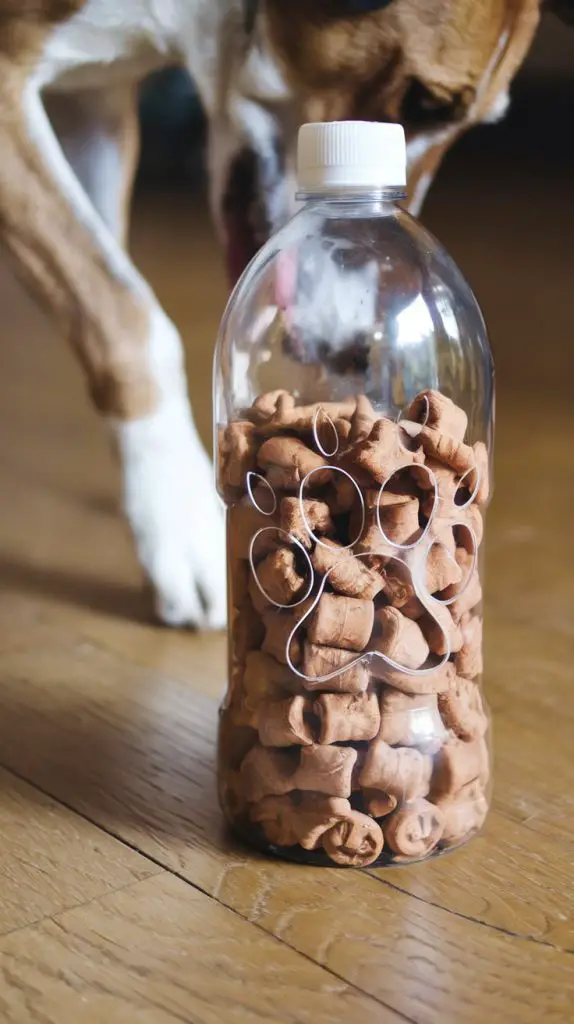
To set up the game, cut a few holes of varying sizes in the bottle, making sure the treats can fall out. Fill the bottle with your dog’s favorite treats, and let them figure out how to retrieve them. This game encourages bottle retrieval and scent exploration as your dog uses their sense of smell to locate the treats.
| Difficulty Level | Gameplay Modifications |
|---|---|
| Easy | Use large holes and a small number of treats |
| Medium | Use medium-sized holes and a moderate number of treats |
| Hard | Use small holes and a large number of treats |
As your dog becomes more confident, you can increase the difficulty level by adjusting the hole sizes and the number of treats. This game is an excellent way to provide mental stimulation and challenge your dog’s problem-solving skills.
4. Snuffle Mat for Dogs
You can take your dog’s sense of smell to the next level with a snuffle mat, a simple yet effective puzzle game that challenges their olfactory abilities. By hiding treats or kibble in the mat’s pockets or compartments, you encourage your dog to sniff and forage, stimulating their brain and slowing down eating.
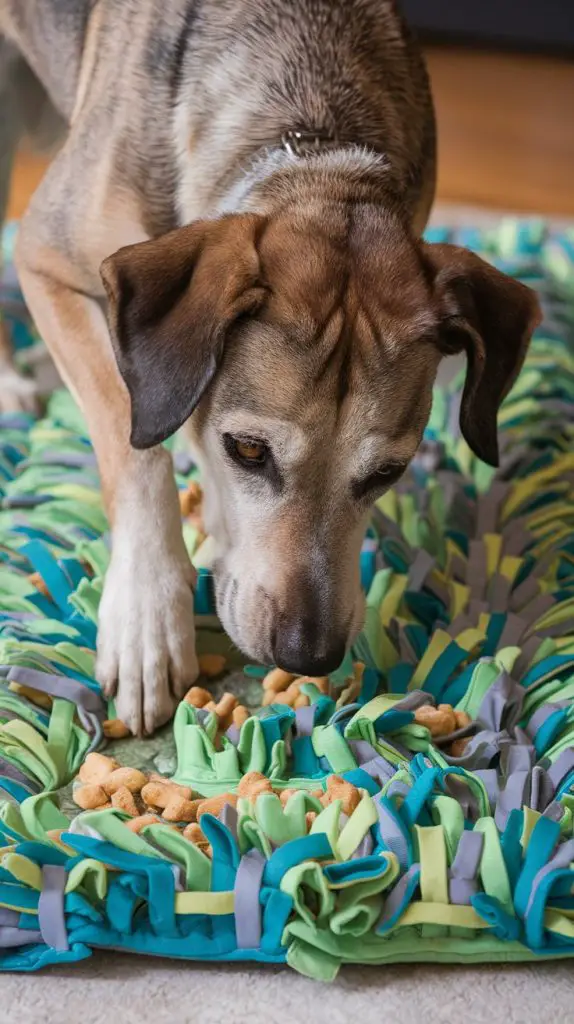
While commercial snuffle mats are available, you can also create a DIY version using materials like high-quality polyester blend, similar to the anti-slip pet mat designed for feeding areas.
Some common features of snuffle mats include:
- Multiple pockets and compartments to hide treats or kibble
- Durable, easy-to-clean materials like cotton or polyester
- Adjustable difficulty levels to suit your dog’s skill level
- Compact design for easy storage and transport
- Non-slip backing to prevent the mat from sliding around
The benefits of snuffle mats are numerous, from reducing boredom and anxiety to improving problem-solving skills and slowing down eating.
If you’re looking for alternatives to snuffle mats, consider using a cardboard box or a muffin tin with hidden treats. These DIY options can provide similar mental stimulation and challenge your dog’s sense of smell.
5. Hidden Treat Obstacle Course
Building on the idea of challenging your dog’s sense of smell with a snuffle mat, a hidden treat obstacle course takes the concept to the next level by adding physical challenges and problem-solving elements.
You’ll create a course with various obstacles, such as tunnels, cones, and jumps, and hide treats throughout it. This activity combines treat hiding, obstacle navigation, and agility training to provide mental and physical stimulation for your dog.
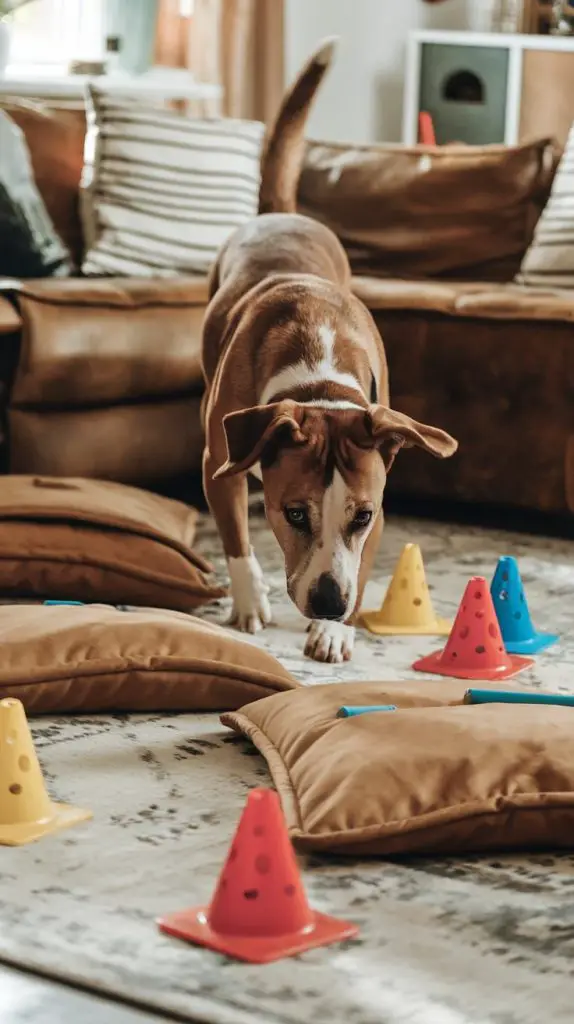
Similar to indoor puppy playpens, this setup offers a designated play area that encourages good behavior and establishes boundaries for play.
As your dog navigates the course, they’ll use their sense of smell for scent exploration, which motivates them to continue through the challenges.
To maintain motivation, use motivation techniques like high-value treats and praise. To keep the activity engaging, change the course layout and puzzle variety regularly.
Monitor your dog’s progress and adjust the difficulty level accordingly. A well-designed reward system is essential to dog engagement and learning.
By providing treats and praise, you’ll reinforce desired behaviors and encourage your dog to continue participating in the activity.
This activity will help strengthen your bond with your dog while providing them with mental and physical stimulation.
6. Muffin Tin Brain Teaser
The Muffin Tin Brain Teaser is a problem-solving game that challenges your dog to figure out how to retrieve treats from a muffin tin. You’ll place treats in some or all of the muffin tin’s cups, and your dog will have to figure out how to get them out. This game provides mental enrichment and is a great example of dog puzzle types that improve problem-solving skills.
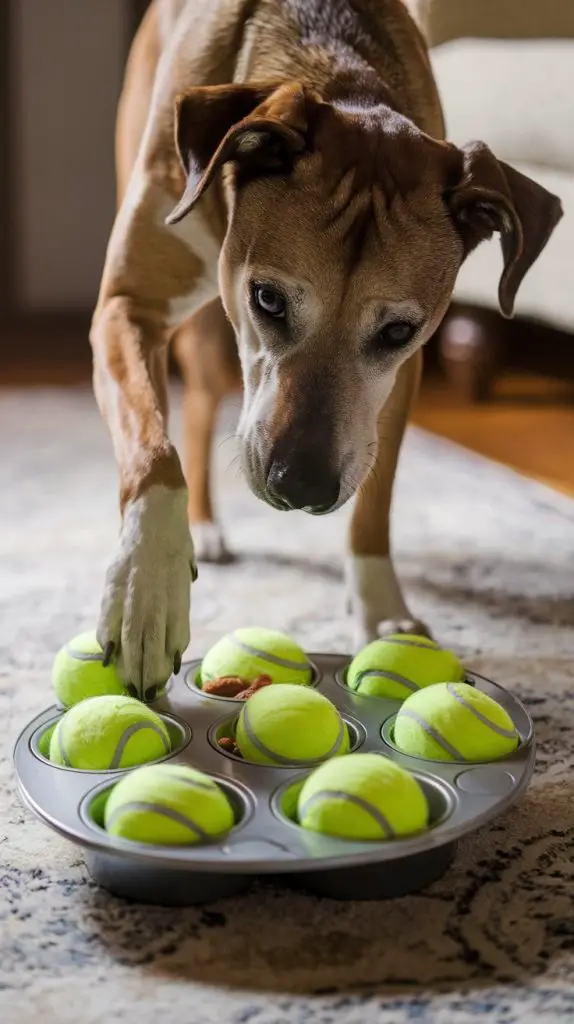
Similar to how the self-cleaning needle comb efficiently removes hair from pets, this game effectively removes boredom and provides mental stimulation for your dog.
To set up the game, you’ll need:
- A standard 12-cup muffin tin
- Treats, such as kibble or small biscuits
- A few tennis balls or small toys to use as obstacles
- A surface to place the muffin tin on, such as a table or countertop
- Optional: a towel or cloth to cover the muffin tin for added challenge
As your dog plays the game, you’ll see them use problem-solving skills to figure out how to retrieve the treats. They may use their paws, nose, or mouth to move the obstacles and get the treats out.
This game is adjustable to your dog’s skill level and provides a fun and challenging way to provide mental stimulation.
7. DIY Sensory Puzzle Box
Sensory puzzle boxes are a type of interactive dog toy that challenge your dog to use their sense of smell and problem-solving skills to retrieve treats. By creating a DIY sensory puzzle box, you provide your dog with scent enrichment and mental stimulation.
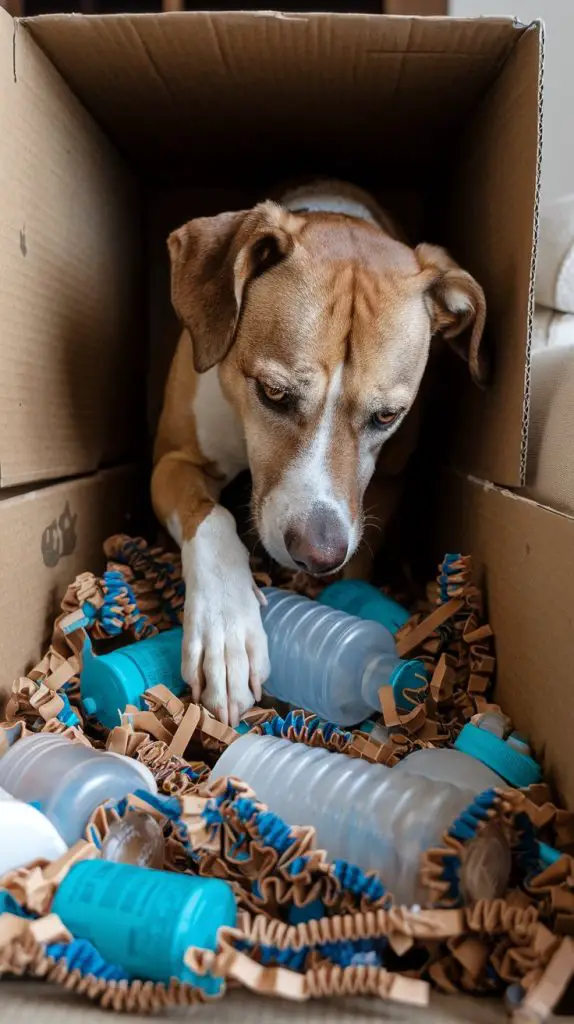
To make a sensory puzzle box, you’ll need a plastic container with holes of varying sizes, treats, and different textures like paper, fabric, or cardboard. This activity can be a great alternative to traditional grooming sessions, promoting bonding and reducing stress for pets who dislike regular brushing.
Cut holes in the container and fill it with treats, then add the different textures to create layers. You can also add a few drops of essential oils to enhance the scent. As your dog works to get the treats out, they’ll engage in texture exploration and use their sense of smell to navigate the layers.
The complexity of the puzzle box can be adjusted based on your dog’s skill level by changing the size of the holes and the number of layers. This interactive toy will keep your dog engaged and mentally stimulated, reducing boredom and destructive behavior.
Frequent Questions on Simple DIY Dog Puzzle Games for Mental Stimulation
What Age Can I Start Introducing Puzzle Games to My Puppy?
You can start introducing puzzle games to your puppy as early as 8-10 weeks old, as this stage of puppy development is essential for building cognitive skills, such as problem-solving and critical thinking.
Can I Use Puzzle Games With Dogs That Have Anxiety or Stress?
Can puzzle games really help anxious dogs find calm? You can use puzzle games to provide anxiety relief and stress reduction for dogs with anxiety or stress, as mental stimulation can be a calming outlet for them.
How Often Should I Rotate Puzzle Games to Keep My Dog Engaged?
You should rotate puzzle games every 3-5 days to maintain your dog’s engagement levels, gradually increasing puzzle difficulty to challenge their problem-solving skills and prevent boredom, while adjusting frequency based on individual responses.
Are There Any Health Benefits to Using Puzzle Games for Dogs?
You’ll find that using puzzle games for your dog yields several health benefits, including enhanced cognitive development and noticeable behavioral improvement, as they challenge and engage your dog’s problem-solving skills and provide mental stimulation.
Can I Use Puzzle Games as a Replacement for Regular Exercise?
You shouldn’t rely solely on puzzle games as a replacement for regular exercise. While they’re excellent for mental stimulation, they don’t provide the physical activity your dog needs; strike a balance between puzzle game effectiveness and exercise.
